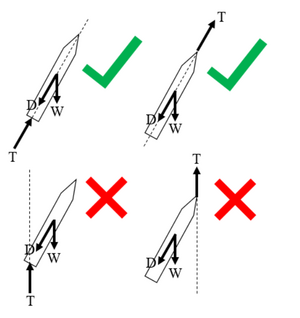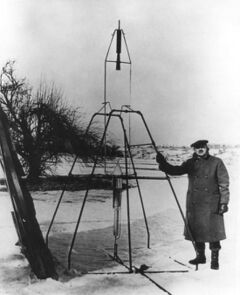Astronomy:Pendulum rocket fallacy
The pendulum rocket fallacy is a common fundamental misunderstanding of the mechanics of rocket flight and how rockets remain on a stable trajectory. The first liquid-fuel rocket, constructed by Robert Goddard in 1926, differed significantly from modern rockets in that the rocket engine was at the top and the fuel tank at the bottom of the rocket. It was believed that, in flight, the rocket would "hang" from the engine like a pendulum from a pivot, and the weight of the fuel tank would be all that was needed to keep the rocket flying straight up. This belief is incorrect. In actuality, the stability of such a rocket is dependent on other factors. Basic Newtonian mechanics shows that Goddard's rocket is just as stable (or unstable) as it would be if the engine had been mounted below the fuel tank (as it is in most modern rockets).[1]
If the engine kept pushing the nose straight up even as the rest of the rocket swung like a pendulum under it, the rocket would have a possibility to get pulled straight and be stable. However, the engines are fixed to the rest of the rocket, so when the rocket tilts, the engine won't apply an upward, stabilising force, but simply push forward in whatever direction the rocket happens to be pointing, not steering it one way or the other at all.
References
- ↑ "Jim Bowery". "The Pendulum Rocket Fallacy". Archived from the original on 2009-10-18. https://web.archive.org/web/20091018232320/http://geocities.com/jim_bowery/pendrock.html. Retrieved 2010-06-30.



